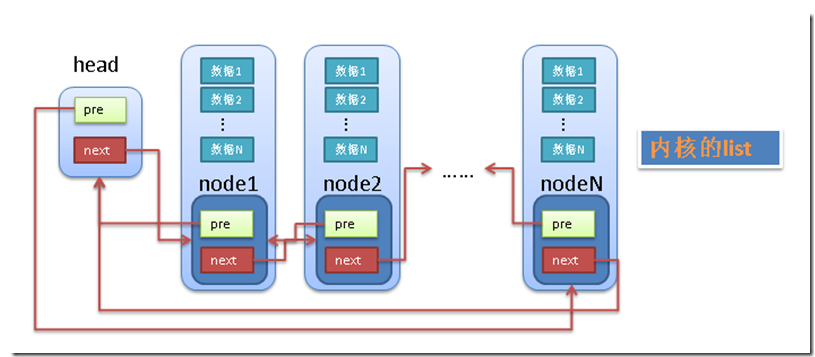linux内核中,有一种通用的双向循环链表,构成了各种队列的基础。链表的结构定义和相关函数均在include/linux/list.h中,下面就来全面的介绍这一链表的各种API。
struct list_head {
struct list_head *next, *prev;
}; 这是链表的元素结构。因为是循环链表,表头和表中节点都是这一结构。有prev和next两个指针,分别指向链表中前一节点和后一节点。
#define LIST_HEAD_INIT(name) { &(name), &(name) }
#define LIST_HEAD(name) \
struct list_head name = LIST_HEAD_INIT(name)
static inline void INIT_LIST_HEAD(struct list_head *list)
{
list->next = list;
list->prev = list;
} 在初始化的时候,链表头的prev和next都是指向自身的
static inline void __list_add(struct list_head *new,
struct list_head *prev,
struct list_head *next)
{
next->prev = new;
new->next = next;
new->prev = prev;
prev->next = new;
}
static inline void list_add(struct list_head *new, struct list_head *head)
{
__list_add(new, head, head->next);
}
static inline void list_add_tail(struct list_head *new, struct list_head *head)
{
__list_add(new, head->prev, head);
} 双向循环链表的实现,很少有例外情况,基本都可以用公共的方式来处理。这里无论是加第一个节点,还是其它的节点,使用的方法都一样。
另外,链表API实现时大致都是分为两层:一层外部的,如list_add、list_add_tail,用来消除一些例外情况,调用内部实现;一层是内部的,函数名前会加双下划线,如__list_add,往往是几个操作公共的部分,或者排除例外后的实现。
static inline void __list_del(struct list_head * prev, struct list_head * next)
{
next->prev = prev;
prev->next = next;
}
static inline void list_del(struct list_head *entry)
{
__list_del(entry->prev, entry->next);
entry->next = LIST_POISON1;
entry->prev = LIST_POISON2;
}
static inline void list_del_init(struct list_head *entry)
{
__list_del(entry->prev, entry->next);
INIT_LIST_HEAD(entry);
} list_del是链表中节点的删除。之所以在调用__list_del后又把被删除元素的next、prev指向特殊的LIST_POSITION1和LIST_POSITION2,是为了调试未定义的指针。
list_del_init则是删除节点后,随即把节点中指针再次初始化,这种删除方式更为实用
static inline void list_replace(struct list_head *old,
struct list_head *new)
{
new->next = old->next;
new->next->prev = new;
new->prev = old->prev;
new->prev->next = new;
}
static inline void list_replace_init(struct list_head *old,
struct list_head *new)
{
list_replace(old, new);
INIT_LIST_HEAD(old);
} list_replace是将链表中一个节点old,替换为另一个节点new。从实现来看,即使old所在地链表只有old一个节点,new也可以成功替换,这就是双向循环链表可怕的通用之处。
list_replace_init将被替换的old随即又初始化。
static inline void list_move(struct list_head *list, struct list_head *head)
{
__list_del(list->prev, list->next);
list_add(list, head);
}
static inline void list_move_tail(struct list_head *list,
struct list_head *head)
{
__list_del(list->prev, list->next);
list_add_tail(list, head);
} list_move的作用是把list节点从原链表中去除,并加入新的链表head中。
list_move_tail只在加入新链表时与list_move有所不同,list_move是加到head之后的链表头部,而list_move_tail是加到head之前的链表尾部。
static inline int list_is_last(const struct list_head *list,
const struct list_head *head)
{
return list->next == head;
} list_is_last 判断list是否处于head链表的尾部。
static inline int list_empty(const struct list_head *head)
{
return head->next == head;
}
static inline int list_empty_careful(const struct list_head *head)
{
struct list_head *next = head->next;
return (next == head) && (next == head->prev);
} list_empty 判断head链表是否为空,为空的意思就是只有一个链表头head。
list_empty_careful 同样是判断head链表是否为空,只是检查更为严格。
static inline int list_is_singular(const struct list_head *head)
{
return !list_empty(head) && (head->next == head->prev);
} list_is_singular 判断head中是否只有一个节点,即除链表头head外只有一个节点。
static inline void __list_cut_position(struct list_head *list,
struct list_head *head, struct list_head *entry)
{
struct list_head *new_first = entry->next;
list->next = head->next;
list->next->prev = list;
list->prev = entry;
entry->next = list;
head->next = new_first;
new_first->prev = head;
}
static inline void list_cut_position(struct list_head *list,
struct list_head *head, struct list_head *entry)
{
if (list_empty(head))
return;
if (list_is_singular(head) &&
(head->next != entry && head != entry))
return;
if (entry == head)
INIT_LIST_HEAD(list);
else
__list_cut_position(list, head, entry);
} list_cut_position 用于把head链表分为两个部分。从head->next一直到entry被从head链表中删除,加入新的链表list。新链表list应该是空的,或者原来的节点都可以被忽略掉。可以看到,list_cut_position中排除了一些意外情况,保证调用__list_cut_position时至少有一个元素会被加入新链表。
static inline void __list_splice(const struct list_head *list,
struct list_head *prev,
struct list_head *next)
{
struct list_head *first = list->next;
struct list_head *last = list->prev;
first->prev = prev;
prev->next = first;
last->next = next;
next->prev = last;
}
static inline void list_splice(const struct list_head *list,
struct list_head *head)
{
if (!list_empty(list))
__list_splice(list, head, head->next);
}
static inline void list_splice_tail(struct list_head *list,
struct list_head *head)
{
if (!list_empty(list))
__list_splice(list, head->prev, head);
} list_splice的功能和list_cut_position正相反,它合并两个链表。list_splice把list链表中的节点加入head链表中。在实际操作之前,要先判断list链表是否为空。它保证调用__list_splice时list链表中至少有一个节点可以被合并到head链表中。
list_splice_tail只是在合并链表时插入的位置不同。list_splice是把原来list链表中的节点全加到head链表的头部,而list_splice_tail则是把原来list链表中的节点全加到head链表的尾部。
static inline void list_splice_init(struct list_head *list,
struct list_head *head)
{
if (!list_empty(list)) {
__list_splice(list, head, head->next);
INIT_LIST_HEAD(list);
}
}
static inline void list_splice_tail_init(struct list_head *list,
struct list_head *head)
{
if (!list_empty(list)) {
__list_splice(list, head->prev, head);
INIT_LIST_HEAD(list);
}
} list_splice_init 除了完成list_splice的功能,还把变空了的list链表头重新初始化。
list_splice_tail_init 除了完成list_splice_tail的功能,还吧变空了得list链表头重新初始化。
list操作的API大致如以上所列,包括链表节点添加与删除、节点从一个链表转移到另一个链表、链表中一个节点被替换为另一个节点、链表的合并与拆分、查看链表当前是否为空或者只有一个节点。接下来,是操作链表遍历时的一些宏,我们也简单介绍一下。
#define list_entry(ptr, type, member) \
container_of(ptr, type, member)
list_entry主要用于从list节点查找其内嵌在的结构。比如定义一个结构struct A{ struct list_head list; }; 如果知道结构中链表的地址ptrList,就可以从ptrList进而获取整个结构的地址(即整个结构的指针) struct A *ptrA = list_entry(ptrList, struct A, list);
这种地址翻译的技巧是linux的拿手好戏,container_of随处可见,只是链表节点多被封装在更复杂的结构中,使用专门的list_entry定义也是为了使用方便。
#define list_first_entry(ptr, type, member) \
list_entry((ptr)->next, type, member)
list_first_entry是将ptr看完一个链表的链表头,取出其中第一个节点对应的结构地址。使用list_first_entry是应保证链表中至少有一个节点。
#define list_for_each(pos, head) \
for (pos = (head)->next; prefetch(pos->next), pos != (head); \
pos = pos->next)
list_for_each循环遍历链表中的每个节点,从链表头部的第一个节点,一直到链表尾部。中间的prefetch是为了利用平台特性加速链表遍历,在某些平台下定义为空,可以忽略。
#define __list_for_each(pos, head) \
for (pos = (head)->next; pos != (head); pos = pos->next)
__list_for_each与list_for_each没什么不同,只是少了prefetch的内容,实现上更为简单易懂。
#define list_for_each_prev(pos, head) \
for (pos = (head)->prev; prefetch(pos->prev), pos != (head); \
pos = pos->prev)
list_for_each_prev与list_for_each的遍历顺序相反,从链表尾逆向遍历到链表头。
#define list_for_each_safe(pos, n, head) \
for (pos = (head)->next, n = pos->next; pos != (head); \
pos = n, n = pos->next)
list_for_each_safe 也是链表顺序遍历,只是更加安全。即使在遍历过程中,当前节点从链表中删除,也不会影响链表的遍历。参数上需要加一个暂存的链表节点指针n。
#define list_for_each_prev_safe(pos, n, head) \
for (pos = (head)->prev, n = pos->prev; \
prefetch(pos->prev), pos != (head); \
pos = n, n = pos->prev)
list_for_each_prev_safe 与list_for_each_prev同样是链表逆序遍历,只是加了链表节点删除保护。
#define list_for_each_entry(pos, head, member) \
for (pos = list_entry((head)->next, typeof(*pos), member); \
prefetch(pos->member.next), &pos->member != (head); \
pos = list_entry(pos->member.next, typeof(*pos), member))
list_for_each_entry不是遍历链表节点,而是遍历链表节点所嵌套进的结构。这个实现上较为复杂,但可以等价于list_for_each加上list_entry的组合。
#define list_for_each_entry_reverse(pos, head, member) \
for (pos = list_entry((head)->prev, typeof(*pos), member); \
prefetch(pos->member.prev), &pos->member != (head); \
pos = list_entry(pos->member.prev, typeof(*pos), member))
list_for_each_entry_reverse 是逆序遍历链表节点所嵌套进的结构,等价于list_for_each_prev加上list_etnry的组合。
#define list_for_each_entry_continue(pos, head, member) \
for (pos = list_entry(pos->member.next, typeof(*pos), member); \
prefetch(pos->member.next), &pos->member != (head); \
pos = list_entry(pos->member.next, typeof(*pos), member))
list_for_each_entry_continue也是遍历链表上的节点嵌套的结构。只是并非从链表头开始,而是从结构指针的下一个结构开始,一直到链表尾部。
#define list_for_each_entry_continue_reverse(pos, head, member) \
for (pos = list_entry(pos->member.prev, typeof(*pos), member); \
prefetch(pos->member.prev), &pos->member != (head); \
pos = list_entry(pos->member.prev, typeof(*pos), member))
list_for_each_entry_continue_reverse 是逆序遍历链表上的节点嵌套的结构。只是并非从链表尾开始,而是从结构指针的前一个结构开始,一直到链表头部。
#define list_for_each_entry_from(pos, head, member) \
for (; prefetch(pos->member.next), &pos->member != (head); \
pos = list_entry(pos->member.next, typeof(*pos), member))
list_for_each_entry_from 是从当前结构指针pos开始,顺序遍历链表上的结构指针。
#define list_for_each_entry_safe(pos, n, head, member) \
for (pos = list_entry((head)->next, typeof(*pos), member), \
n = list_entry(pos->member.next, typeof(*pos), member); \
&pos->member != (head); \
pos = n, n = list_entry(n->member.next, typeof(*n), member))
list_for_each_entry_safe 也是顺序遍历链表上节点嵌套的结构。只是加了删除节点的保护。
#define list_for_each_entry_safe_continue(pos, n, head, member) \
for (pos = list_entry(pos->member.next, typeof(*pos), member), \
n = list_entry(pos->member.next, typeof(*pos), member); \
&pos->member != (head); \
pos = n, n = list_entry(n->member.next, typeof(*n), member))
list_for_each_entry_safe_continue 是从pos的下一个结构指针开始,顺序遍历链表上的结构指针,同时加了节点删除保护。
#define list_for_each_entry_safe_from(pos, n, head, member) \
for (n = list_entry(pos->member.next, typeof(*pos), member); \
&pos->member != (head); \
pos = n, n = list_entry(n->member.next, typeof(*n), member))
list_for_each_entry_safe_from 是从pos开始,顺序遍历链表上的结构指针,同时加了节点删除保护。
#define list_for_each_entry_safe_reverse(pos, n, head, member) \
for (pos = list_entry((head)->prev, typeof(*pos), member), \
n = list_entry(pos->member.prev, typeof(*pos), member); \
&pos->member != (head); \
pos = n, n = list_entry(n->member.prev, typeof(*n), member))
list_for_each_entry_safe_reverse 是从pos的前一个结构指针开始,逆序遍历链表上的结构指针,同时加了节点删除保护。
至此为止,我们介绍了linux中双向循环链表的结构、所有的操作函数和遍历宏定义。相信以后在linux代码中遇到链表的使用,不会再陌生。
一般的双向链表一般是如下的结构:
- 有个单独的头结点(head)
- 每个节点(node)除了包含必要的数据之外,还有2个指针(pre,next)
- pre指针指向前一个节点(node),next指针指向后一个节点(node)
- 头结点(head)的pre指针指向链表的最后一个节点
- 最后一个节点的next指针指向头结点(head)
具体见下图:

传统的链表有个最大的缺点就是不好共通化,因为每个node中的data1,data2等等都是不确定的(无论是个数还是类型)。
linux中的链表巧妙的解决了这个问题,linux的链表不是将用户数据保存在链表节点中,而是将链表节点保存在用户数据中。
linux的链表节点只有2个指针(pre和next),这样的话,链表的节点将独立于用户数据之外,便于实现链表的共同操作。
具体见下图:
linux链表中的最大问题是怎样通过链表的节点来取得用户数据,
和传统的链表不同,linux的链表节点(node)中没有包含用户的用户data1,data2等。
解决这个问题是list_entry中的container_of这个宏
#define container_of(ptr, type, member) ({ \
const typeof(((type *)0)->member)*__mptr = (ptr); \
(type *)((char *)__mptr - offsetof(type, member)); })
实例:
构建一个带有list_head的结构体
struct student
{
int id;
char* name;
struct list_head list;
};- type是struct student
- ptr是指向stuct list的指针,也就是指向member类型的指针
- member就是 list
下面分析一下container_of宏:
// 步骤1:将数字0强制转型为type*,然后取得其中的member元素
((type *)0)->member // 相当于((struct student *)0)->list
// 步骤2:定义一个临时变量__mptr,并将其也指向ptr所指向的链表节点
const typeof(((type *)0)->member)*__mptr = (ptr);
// 步骤3:计算member字段距离type中第一个字段的距离,也就是type地址和member地址之间的差
// offset(type, member)也是一个宏,定义如下:
#define offsetof(TYPE, MEMBER) ((size_t) &((TYPE *)0)->MEMBER)
// 步骤4:将__mptr的地址 - type地址和member地址之间的差
// 其实也就是获取type的地址步骤1,2,4比较容易理解,下面的图以sturct student为例进行说明步骤3:
首先需要知道 ((TYPE *)0) 表示将地址0转换为 TYPE 类型的地址
由于TYPE的地址是0,所以((TYPE *)0)->MEMBER 也就是 MEMBER的地址和TYPE地址的差,如下图所示:
























 733
733

 被折叠的 条评论
为什么被折叠?
被折叠的 条评论
为什么被折叠?








